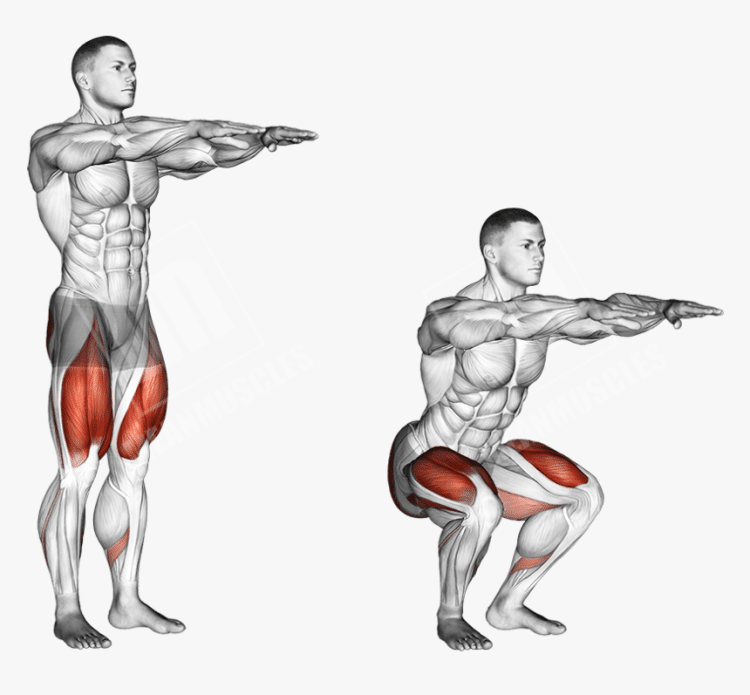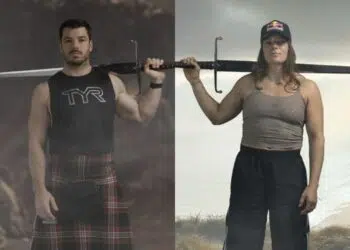It’s hard to believe that CrossFit has been around for over 20 years. Initially labeled a bit of a fad, CrossFit is now one of the most popular workouts and is a bonafide global fitness phenomenon, not to mention a competitive sport. Just wait – it’ll probably be in the Olympics someday soon.
So, love it or loath it, CrossFit is definitely here to stay!
CrossFit has introduced and popularized a wide range of exercises to the general public, usually as part of their regular WODs – that’s Workout Of the Day to you and me.
Moves like thrusters, sumo deadlift high pulls, kettlebell swings, handstand push-ups, double unders, and battle ropes aren’t new exercises. Still, they’re definitely more well-known because of CrossFit.
Another CrossFit staple is the air squat, which features in a large number of WODs.
But, it’s not just CrossFitters that can benefit from air squats – they’re a useful exercise even if you aren’t a CrossFit fan.
Level Up Your Fitness: Join our 💪 strong community in Fitness Volt Newsletter. Get daily inspiration, expert-backed workouts, nutrition tips, the latest in strength sports, and the support you need to reach your goals. Subscribe for free!
In this guide, we reveal why and how to do air squats and provide you with some great variations and alternatives you can use to stop your workouts from becoming dull.
Air Squats – Muscles Worked
Air squats are a compound exercise. That means they involve two or more joints and several muscles working together. In fact, air squats work virtually every muscle in your lower body, making them a very time-efficient and functional lower body exercise.
That said, the main muscles working during air squats are:
Quadriceps – these are the muscles you’ll probably feel most during air squats. Located on the front of your thighs, the quadriceps are responsible for extending your knees. Known as the quads for short, there are four quadriceps muscles: the vastus lateralis, vastus medialis, vastus intermedius, and rectus femoris.
Hamstrings – located on the back of your thighs, the hamstrings flex your knees and extend your hips. There are three hamstring muscles: the semimembranosus, semitendinosus, and biceps femoris. The deeper you descend during air squats, the more work the hamstrings do.
Gluteus maximus – this is the largest muscle in the human body. Known as the glutes for short, this powerful muscle works with your hamstrings to extend your hips. The glutes are basically your butt. Like the hamstrings, doing deep air squats increase glute activation.
Gluteus medius, minimus, and tensor fascia latae – collectively known as the abductors, these three muscles lift your leg out and away from the midline of your body. They’re located on the outside of your hips and thighs. During air squats, the abductors work to stop your knees from falling inward.
Adductor longus, brevis, and magnus – the three adductor muscles are located on the inside of your thighs. They’re responsible for drawing your legs into the midline of your body. During air squats, the adductors stop your knees from falling outward.
Core – the collective name for the muscles of your midsection, the core helps support and stabilize your lumbar spine during air squats. However, as air squats are done without weight, their involvement is pretty minimal. The main core muscles are the rectus abdominis, obliques, transverse abdominis, and erector spinae.
Gastrocnemius and soleus – collectively known as the triceps surae, these muscles as basically your calves. During air squats, the gastrocnemius and soleus help stabilize your ankles.
How to Do Air Squat
Get more from air squats while keeping your risk of injury to a minimum by following these guidelines:
- Stand with your feet roughly shoulder-width apart, toes turned very slightly outward. Hold your arms down by your sides, look straight ahead, and pull your shoulders down and back. Brace your core.
- Bend your knees, push your hips back, and squat down until your hips are at least level with your knees and your thighs are parallel to the floor. Raise your arms forward to shoulder height for balance.
- Descend further if your mobility and knee health allow. Do not round your lower back. Make sure your heels stay firmly planted on the floor.
- Stand back up, fully extending your knees and hips at the top of each rep. Lower your arms as you ascend.
- Reset your core, breathe, and repeat.
Air Squat Benefits
Not sure if air squats deserve a place in your workouts? Consider these benefits and then decide!
A very functional exercise – squats are more than a workout; they’re also a functional movement. That means they’re something that most people do several times a day, such as when using a chair or getting in and out of your car. As such, air squats will have a positive effect on your ability to carry out many everyday activities.
No equipment required – you can do air squats anywhere and anytime because they need no equipment. As such, they’re ideal for home workouts or for training “on the go,” e.g., in hotel rooms, parks, etc.
Quick set-up time – with no equipment involved, you can quickly start a set of air squats. As such, they’re ideal for fast-paced workouts like HIIT and circuit training.
A good conditioning exercise – a high rep set of air squats will increase your heart and breathing rate, improving your cardiovascular and muscular fitness at the same time. As such, this is an excellent fitness exercise, although it’s not so good for building strength or muscle size.
Good for muscular endurance – muscular endurance is your ability to keep repping out for extended periods. If you want to walk, run, or cycle further and with less fatigue, air squats could help.
Easy to learn – the air squat is a pretty simple exercise, which makes it ideal for beginners and less fit people. Squats are a fundamental exercise, and the air squat is an excellent entry-level variation that most people should be able to learn quite quickly.
Learn and master the squat – air squats are an excellent preparatory exercise before moving onto weighted squats. In fact, you should master air squats before trying barbell, dumbbell, or kettlebell squats.
Air Squat Drawbacks
While air squats are a mostly beneficial exercise, there are also a couple drawbacks to consider:
Limited overload – air squats are so-called because there is no additional load involved. As such, you may find them too easy to be challenging unless you do very high reps. While high rep training can help improve muscular endurance and general fitness, it’s less useful for building strength or muscle size. Doing lots of reps per set is also an inefficient use of your training time.
Tendency to cheat – slow, controlled, deep air squats are a very effective exercise. However, in most CrossFit workouts, they’re done against the clock, so there is a tendency for some people to do them incorrectly. Dropping down too quickly, bouncing out the bottom, and not standing fully upright are just three ways you can mess up air squats, making them less effective and potentially dangerous.
10 Air Squat Variations and Alternatives
Air squats are a highly effective lower body exercise, but that doesn’t mean you need to do them all the time. There are several variations and alternatives you can use to keep your workouts productive and interesting:
Level Up Your Fitness: Join our 💪 strong community in Fitness Volt Newsletter. Get daily inspiration, expert-backed workouts, nutrition tips, the latest in strength sports, and the support you need to reach your goals. Subscribe for free!
1. Deep knee bends
Air squats are done with your heels planted firmly on the floor. In fact, lifting your heels is viewed as a technical flaw for this exercise. In contrast, deep knee bends are done with a purposeful heel lift, which is something that often happens naturally during squatting movements. Raising your heels also increases the range of motion and introduces a balance component to squatting.
How to do it:
- Stand with your feet about hip-width apart, toes pointing forward. Pull your shoulders down and back, brace your core, and let your arms hang naturally by your sides. Lengthen your neck and look straight ahead.
- Keeping your torso as upright as possible, bend your legs, and push your knees forward. Allow your heels to naturally lift off the floor as you descend.
- Raise your arms forward in front of you if you wish. This makes balancing easier.
- Squat down as far as you can, ideally until your hamstrings are resting on your calves.
- Stay in this position for as long as required, e.g., 20-40 seconds, and then stand back up again. Alternatively, you can do this exercise for reps.
2. Hindu squats
The Hindu squat is a variation of the air squat. It’s traditionally used by Indian and western wrestlers as a conditioning exercise. The Hindu squat combines an upper-body movement with the leg action to work virtually every muscle in the body. Done for high reps, this exercise is excellent for developing muscular endurance and has a welcome cardiovascular conditioning effect.
How to do it:
- Stand with your feet about hip-width apart, toes pointing forward. Raise your arms out in front of you so they’re parallel to the floor. Lengthen your neck and look straight ahead.
- Breathe in and “row” your hands into your shoulders.
- Next, bend your legs and squat down as deep as possible while simultaneously reaching down and back with your arms. Allow your heels to lift off the floor as you descend.
- Raise your arms forward and back up to parallel as you drive your feet into the floor and stand back up. Lower your heels back to the floor as you ascend. Exhale as you return to standing.
- Repeat without pausing.
- Hindu squats should be performed smoothly and in time with your breaths.
3. Sissy squats
Air squats are a good conditioning exercise for most exercisers but less useful for building muscle size or strength. They just aren’t challenging enough. Sissy squats put your muscles and joints in a much less biomechanically advantageous position, making them far more demanding. As such, even done with just your body weight, sissy squats are a superb bodybuilding exercise.
How to do it:
- Stand next to a wall or some other object you can use for balance.
- Rise up onto your tiptoes.
- Push your hips and knees forward and squat down as you simultaneously lean back. Descend as far as you can, ideally until your shins are roughly parallel to the floor.
- Drive your toes into the floor and stand back up.
- Tense your quads and glutes at the top of each rep and repeat.
Read also: Weighted Sissy Squat
4. Squat jumps
Where air squats are a conditioning and endurance exercise, squat jumps are more about improving muscle power, which is your ability to generate force quickly. Power is an integral part of most sports. So, if you want to run faster, jump higher, or kick harder, this exercise will help.
How to do it:
- Stand with your feet shoulder-width apart. Brace your abs, pull your shoulders down and back, and look straight ahead.
- Bend your legs and squat down, so your thighs are roughly parallel to the floor. Extend your arms behind you as you descend.
- Extend your legs and swing your arms forward and up. Leap into the air as high as you can.
- Land on slightly bent legs to absorb the impact and then descend into another rep.
Read also: How To Do The Jump Squat
5. Box jumps
Squats jumps (exercise #4) are a great exercise, but they also include a lot of impact. After all, what goes up must come down, right? Box jumps involve jumping up but then landing on a raised platform, which means less impact and a safer workout. This is a good option if you’ve got achy knees and hips or are overweight.
How to do it:
- Stand a couple of feet behind a strong box, sturdy bench, or stable step. Start with something about knee height and increase only when you’ve mastered the basic movement. Your feet should be between shoulder and hip-width apart.
- Bend your knees and swing your arms behind you.
- Swing your arms forward and jump up onto the platform. Land with your knees slightly bent to minimize the shock of landing.
- Step down to the floor, reset your feet, and repeat.
6. Step-ups
While step-ups might not look much like air squats, the movement is actually very similar, except you’ll be working one leg at a time. Using just one leg means your muscles are under greater load, which should produce better strength increases than air squats.
How to do it:
- Stand a couple of feet behind a box, sturdy bench, or step. Start with something less than knee-height and increase only when you’ve mastered the basic movement.
- Starting with your feet together, bend one leg and place your foot on top of the platform. Drive your foot into the top of your platform and stand up on top.
- Step down with the same leg and then switch, so you’re leading with the opposite foot.
- Continue alternating legs for the required number of reps.
7. Lunges
Lunges, like air squats, can be done using nothing more than body weight for resistance. However, lunges increase the load on your front leg, which makes them a little more challenging. Lunges are also good for improving coordination, hip mobility, and balance.
How to do it:
- Stand with your feet together and your arms by your sides. Pull your shoulders down and back and look straight ahead.
- Take a big step forward, bend your legs, and lower your back knee down to within an inch of the floor. Keep your front shin and torso as vertical as possible.
- Push off your front leg and return to the starting position.
- Step forward and out with the opposite leg and repeat.
- Alternate legs for the required number of reps.
8. Bulgarian split squats
Mastered lunges? Good for you! Make your workouts more challenging and productive with Bulgarian split squats. This exercise is similar to lunges, but it puts more weight on your front leg and involves more balance and a greater range of motion. Done with or without weights, this is an excellent alternative to air squats.
How to do it:
- Stand with your back to a knee-high step or bench. Bend one leg and place the top of your foot on the bench. Hop forward into a split stance. Let your arms hang down by your sides. Pull your shoulders down and back and brace your core.
- Bend your legs and descend until your rear knee is roughly an inch above the floor. Keep your front shin and torso vertical.
- Stand back up and repeat for the desired number of reps.
- Rest a moment, swap legs, and repeat. Try to do the same number of reps on both legs.
Related: The Complete Guide To Bulgarian Split Squats
9. Pistols
This pistol squat is a deep single-leg squat. As such, it’s a useful progression if you’ve mastered air squats and are looking for a way to develop strength as well as balance and mobility. Be warned – this is a challenging exercise, so don’t be surprised if you don’t get it right away. If necessary, you can use your arms for assistance to make it more manageable.
How to do it:
- Stand with your feet together and raise your arms out in front of you for balance.
- Shift your weight onto one leg. Bend your supporting knee and squat all the way down while keeping your other leg extended out in front of you. Keep your torso as upright as possible.
- Keeping your arms extended in front of you, drive your foot into the floor and stand back up.
- Repeat for the desired number of repetitions and then do the same number of reps with the opposite leg.
10. Goblet squats
If air squats have a downside, it’s that you’re limited to using your body weight for resistance. If you’re already pretty strong, this could mean that air squats simply aren’t challenging enough for you. Fix this problem by using a single kettlebell or dumbbell for added resistance. The squatting motion remains virtually unchanged, making this a logical way to make air squats a little more demanding.
How to do it:
- Stand with your feet about shoulder-width apart, toes turned slightly outward. Hold a kettlebell or dumbbell in front of your chest and just below your chin. Pull your shoulders down and back and brace your abs.
- Bend your legs, push your hips to the rear, and squat down until your thighs are at least parallel to the floor. Take care not to round your lower back.
- Stand back up and repeat.
Air Squats – Wrapping Up
The air squat is a fundamental exercise that features in many CrossFit workouts. It’s also ideal for home exercisers, HIIT and circuit workouts, and general fitness training. Air squats teach you how to squat correctly and are an excellent preparatory exercise for weighted squats, i.e., barbell back and front squats.
That said, some stronger exercises may find air squats somewhat redundant. After all, with just your body weight for resistance, fit individuals could find it necessary to do very high reps to fatigue their muscles, and that’s often a waste of valuable training time.
The good news is that there are plenty of variations and alternatives you can use that may be more suitable for experienced exercisers. But, even then, strong exercisers can still use air squats as a warm-up exercise or as a finisher after a heavy leg training session.
Interested in measuring your progress? Check out our strength standards for Push Ups, Bulgarian Split Squat, Goblet Squat, and more.









